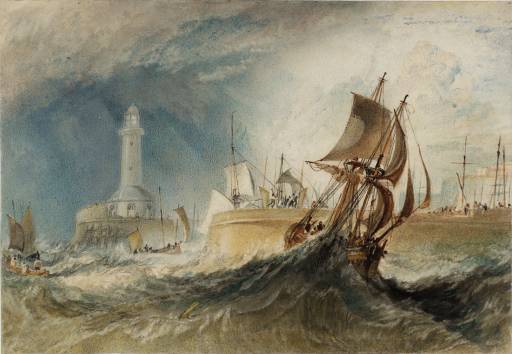Joseph Mallord William Turner Ramsgate c.1824
Joseph Mallord William Turner,
Ramsgate
c.1824
Joseph Mallord William Turner 1775–1851
Ramsgate c.1824
D18150
Turner Bequest CCVIII Q
Turner Bequest CCVIII Q
Graphite and watercolour on white wove watercolour paper, 160 x 232 mm
Blind-stamped with Turner Bequest monogram bottom left
Blind-stamped with Turner Bequest monogram bottom left
Accepted by the nation as part of the Turner Bequest 1856
Exhibition history
1904
National Gallery, London, various dates to at least 1904 (377).
1936
[Display of Watercolours], National Gallery, London, November 1936–September 1939 (no catalogue).
1989
[?] Turner & the Coast of Kent, Canterbury Festival, Canterbury City Museums, October 1989 (no catalogue entries or list of works).
1992
Turner as Professor: The Artist and Linear Perspective, Tate Gallery, London, October 1992–January 1993 (140).
1997
J.M.W. Turner 1775–1851: A Tate Gallery Collection Exhibition, Yokohama Museum of Art, June–August 1997, Fukuoka Art Museum, September–October 1997, Nagoya City Art Museum, October–December 1997 (45, reproduced in colour).
1997
Joseph Mallord William Turner, Bank Austria Kunstforum, Vienna, March–June 1997 (53, reproduced in colour, and in detail, p.[208]).
2000
Ruskin, Turner, and the Pre-Raphaelites, Tate Britain, London, March–May 2000 (60, reproduced in colour).
2001
William Turner: Licht und Farbe, Museum Folkwang, Essen, September 2001–January 2002, Kunsthaus Zürich, February–May 2002 (85, reproduced in colour).
2005
Turner’s Picture of Britain, Clore Gallery, Tate Britain, London, June 2005–April 2006 (no catalogue).
2011
William Turner. Maler der Elemente/ Turner and the Elements, Bucerius Kunst Forum, Hamburg, June–September 2011, Muzeum Narodowe, Krakow, October–January 2012, Turner Contemporary, Margate, January–May 2012 (26).
References
1904
E.T. Cook and Alexander Wedderburn (eds.), Library Edition: The Works of John Ruskin: Volume XIII: Turner: The Harbours of England; Catalogues and Notes, London 1904, pp.53–4; 626, no.377, as ‘Ramsgate’.
1909
A.J. Finberg, A Complete Inventory of the Drawings of the Turner Bequest, London 1909, vol.II, p.630, CCVIII Q, as ‘Ramsgate’.
1979
Andrew Wilton, J.M.W. Turner: His Life and Work, Fribourg 1979, p.387, no.754.
1990
Eric Shanes, Turner’s England 1810–38, London 1990, p.132 no.104 (colour).
2001
David Blayney Brown and Kenneth Reedie, Turner and Kent, exhibition catalogue, Royal Museum & Art Gallery, Canterbury 2001, p.10.
Ramsgate is the third Kent subject published by Thomas Lupton in the Ports series. It is a development from a picture of the town represented on the same day and depicting the same ships entering the harbour mouth from the north in the Picturesque Views on the Southern Coast of England series (Tate impressions T05232–T05235, T04412, T04413, T05991).1 Both of these drawings of Ramsgate are based on a study in the Richmond Hill; Hastings to Margate sketchbook of about 1816–8 (Tate D10576; Turner Bequest CXL 85). A colour study for the present drawing is dated around 1824–5 (Tate D25422; Turner Bequest CCLXIII 299).
Owing to its geographical proximity to mainland Europe, Ramsgate functioned as a chief embarkation point during the Napoleonic Wars (1803–15). The impenetrable stone walls of the harbour and the stolid presence of the lighthouse evoke some of this military history. The mariners struggling to control the moored ships against the intensity and velocity of the wind certainly speaks for the fortitude and resilience which came to signify British maritime prowess.
The sunken viewpoint and the zone of turbulent sea positioned between the viewer and the brig creates the sensation of being on the water itself, the viewer sharing in the dramatic tension of the scene and the churning pitch and roll of the brig. Ruskin writes that this ‘lifting of the brig on the wave is very daring; just one of the things which is seen in a gale, but which no other painter than Turner ever represented’, a comment on the artist’s intuitive interpretation of the elements.2
Eric Shanes notes that the composition is ‘artfully structured: on the left the stormy sky throws forward the lighter-toned sea and lighthouse, while on the right the effect is reversed’ by the sombre swell of the sea and precise, darkened delineation of the rigging and masts of the brig.3 The stippling technique used adds ‘both a sense of movement and textural dynamism’ to the representation of this vital, elemental scene.4 Turner’s rendering of the clouds above the brig also deserves note: the contours of the cumuli are outlined in the finest of line, their delicacy contrasting with the vessel’s rectilinear forms.
Ruskin also found in this drawing the truest expression of Turner’s facility to represent events from memory and the power of his conceptions. Ramsgate was evidence of the artist’s ‘highest imaginative power’.5 He writes that:
on a common mind, what it has seen is so feebly impressed, that it mixes other ideas with it immediately; forgets it–modifies it–adorns it,–does anything but keep hold of it. But when Turner had once seen that stormy hour at Ramsgate harbour-mouth, he never quitted his grasp of it...the impression on his imagination is so strong.6
For other of Turner’s sketches of Ramsgate see the Richmond Hill; Hastings to Margate sketchbook (Tate D10451, D10452–D10455, D10460, D10578, D10583–D10585; Turner Bequest CXL 22a, 23–24a, 27, 86, 89–90). See also the Gravesend and Margate sketchbook of about 1832 (Tate D27332–D27333, D27336–D27340, D27343; Turner Bequest CCLXXIX 35a, 36, 37a–39a, 41). See finally the Kent sketchbook of about 1845–6 (Tate D35826–D35827, D35834; Turner Bequest CCCLXIII 38a, 39, 42a).
This drawing was engraved in mezzotint by Thomas Lupton and published in 1827 (Tate impressions T04830–T04831).
Technical notes:
The back of the sheet has been painted with a very dilute layer of greyish watercolour wash. There are some marks in dark grey wash at the top left of the sheet and in red wash at the top right.
Verso:
Stamped in black with Turner Bequest monogram at centre and with ‘CCVIII Q’ at centre towards top; inscribed in pencil ‘Q’ towards top left and ‘38’ at centre towards left.
Alice Rylance-Watson
March 2013
How to cite
Alice Rylance-Watson, ‘Ramsgate c.1824 by Joseph Mallord William Turner’, catalogue entry, March 2013, in David Blayney Brown (ed.), J.M.W. Turner: Sketchbooks, Drawings and Watercolours, Tate Research Publication, September 2014, https://www

